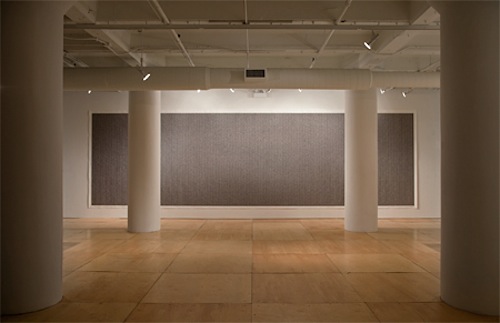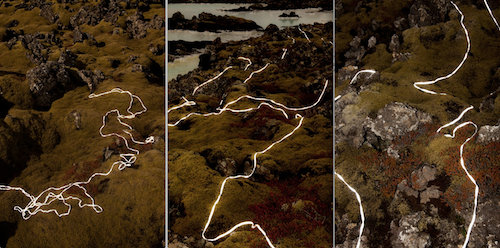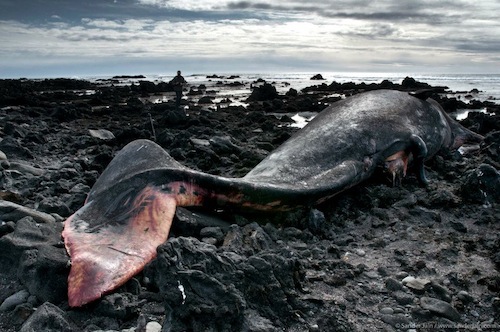Christopher Meerdo’s deep interest in Icelandic culture and geography led him to apply for the three-month SIM International Artist Residency in Reykjavik, Iceland, where he was based from February to April 2012. Now back in Chicago, Meerdo says the residency has changed his practice, jolting him out of the fast pace of his MFA program, and back into the natural landscape and rhythms of art making. “Iceland had such a natural draw for my practice, both ideologically and aesthetically speaking,” says Meerdo. “During my stay, I visited places, from the columnar basalt formations of the black sand beaches at Reynisfjara to Verne Global’s state-of-the-art carbon neutral data center housed in the post-military outpost at Keflavik.”
Before Meerdo left for Iceland, he was working on a project based on Wikileaks data—a perfect tie-in to Iceland, where individuals involved with Wikileaks were working to make the country an international, legal safe haven for corporate and governmental whistle-blowers. Meerdo was already researching the topic and making work about it before setting up his studio in Iceland.
In Cipher (2011) he utilizes data from a 1.5 GB file that Wikileaks founder Julian Assange released mid-2010, via website, to just a few people. Assange declared the site a “thermo-nuclear device” that would detonate and release the file’s passwords, if anything happened to him or the Wikileaks organization. The contents of the document are still unknown. Meerdo visualizes the file through a script, translating the raw binary data into pure black-and-white pixels, and then prints it onto one 350-inch-wide sheet of paper. This project was followed up by Meerdo’s multi-part piece Chinga La Migra (Fuck The Border Patrol) (2011), images based on data visualization of classified documents from the Arizona Border Patrol, supplied by an unnamed hacktivist group. Meerdo converted each file into a RGB visualization based on, again, its binary data. Through these images (available on the artist’s Tumblr blog chinga-la-migra.tumblr.com), Meerdo questions notions of illicit data.

Christopher Meerdo. “Cipher (insurance.aes256),” 2011. Inkjet on seamless paper. Courtesy the artist.
These projects, and the culmination of grad school too, were at the forefront of Meerdo’s mind as he traveled to Iceland. But the ideas he brought with him were gone almost as soon as he set foot on this surreal island country. “Going abroad after completing my MFA was a really good move—like hitting some kind of reset button on my thought processes and creative outlook,” says Meerdo. “Being in the Icelandic landscape gave me a renewed sense of self, space and materiality.”
Access to materials was limited, however, offering a challenge that forced Meerdo further away from his original project idea.”When purchasing wood at a lumberyard, I discovered a lot of what they had in stock was freighted over from the Baltics. In addition to expensive and scarce materials, services are hard to come by; everything from renting a car to printing at a lab was a more involved process.”
And this is why the images Meerdo shot in Iceland ended up having nothing to do with visualizing hacktivists’ data.
Taking a cue from post-Photoshop notions of photography, and the idea that a photograph is less truthful than we think, Meerdo brings to the fore what he calls “scale-less-ness” in the Icelandic landscape. He has photographed two distinct pieces of land: In the triptych Svartsengi, Iceland (2012), he captures the landscape from above and has inserted into the images themselves white lines made from retro-reflective fabric. In the diptych Kirkjufell, Iceland (2012), he inserts a glowing white square made of the same fabric into the middle of a photograph of a meadow, and another of a waterfall. These two works became part of the larger series that Meerdo produced in Iceland, which is anchored by an image of a deceased sperm whale. Titled Saefellsnes Whale (2012), this photograph captures a sperm whale that Meerdo found washed up at the foot of the Snæfellsjökull, a Western volcano and peninsula that Jules Verne writes of in A Journey to the Center of the Earth.
“This is by far the most existential experience I have ever had in my life, given the sheer enormity and unbelievable corporeality of this misplaced giant,” says Meerdo. “It was both beautiful and horrifying, and most striking was the sense of emptiness and disappearance surrounding this creature.”
Meerdo meticulously documented the whale, wandering about its body despite the wafting stench of death.
“I walked alongside his great underbelly, and found myself suddenly standing next to an enormous whale penis. As I contemplated this great metaphor of sexuality and death, I realized that my entire body was almost the exact same size as this giant dick. I don’t think one has really put themselves and their existence into perspective until they’ve stood next to a giant dead whale penis.”
Meerdo and Elspeth Vance, who he spent time with at the residency, took a cue from the whale for their collaborative project. Together, they are recreating a 45-foot-long whale as a soft sculpture, making use of the same reflective material seen in Meerdo’s diptych and triptych. For Meerdo, who has survived three near-death experiences, including drowning and crashing in an airplane, the whale proved a powerful symbol of life, sex, death, and the natural landscape—all of which are essentially unknown.
Christopher Meerdo (b.1981) is a Chicago—based artist who grew up in the Upper Peninsula of Michigan and spent time in post-soviet Lithuania as a teenager. Meerdo recently received an MFA in Photography from the University of Illinois at Chicago. His work has been shown in numerous locations, including Reykjavik, Nottingham, Seattle, Toronto, New York, and Chicago where he has shown at Gallery 400, Hyde Park Art Center, Roxaboxen, and Roots & Culture. Meerdo teaches photography at the School of the Art Institute of Chicago.
Alicia Eler is Blogger-in-Residence through February 28.








Pingback: France is for Phonies: Julie Lequin Isolated in Paris | Art21 Blog
Pingback: Christopher Meerdo > Anthology | document